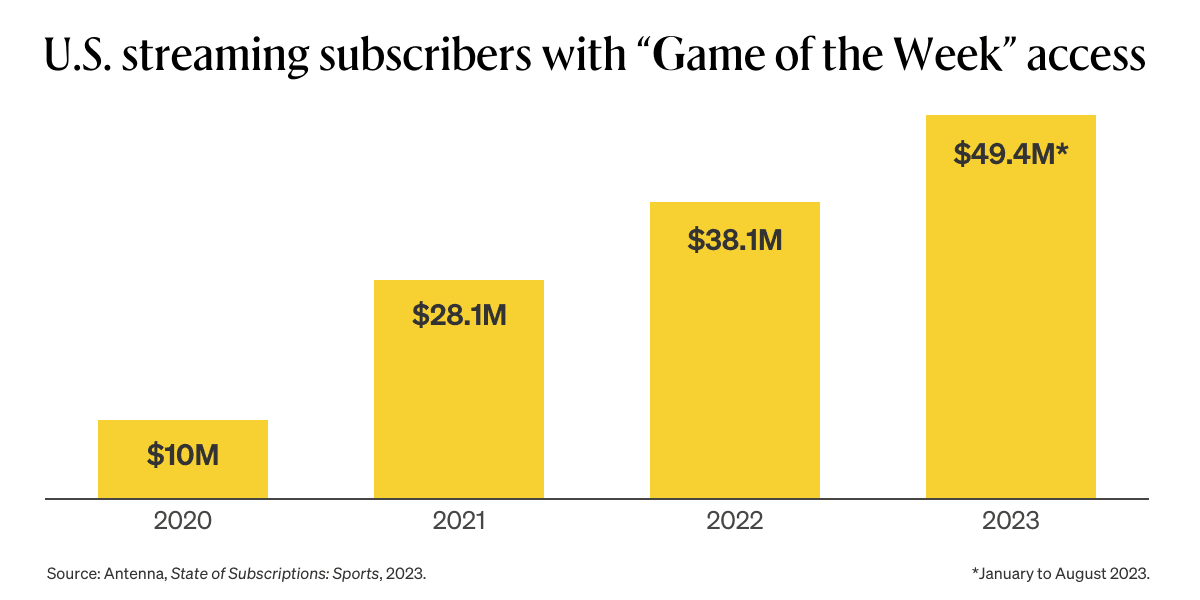‘It’s not a matter of if streaming will take over, it’s a matter of when’: Streamers bet on the growing live sports opportunity

The trend of streaming live sports is gaining momentum, and new data sheds light on the shift from linear TV.
Many of the major streaming platforms now offer live sports programming; most recently, Warner Bros. Discovery’s Max launched a sports tier under the Bleacher Report brand. And Disney is preparing to launch a streaming version of the ESPN cable network.
Antenna, which analyzes subscription data, recently released its Q4 2023 Antenna State of Subscriptions: Sports report that shows how the audience for sports on streaming has rapidly grown in recent years in the U.S., and suggests streamers are already seeing the benefits of a push into live sports, including attracting younger viewers and retaining subscribers that sign up for sporting events. Sports could become even more important for streamers in 2024, after the recent Hollywood writers’ and actors’ strikes dealt a significant blow to production schedules.
But the future remains complicated, analysts wrote in the report, because “about half of American households have linear pay-TV, and half don’t, so sports rights holders need licensing deals that accommodate both groups.” Patrick Crakes, a sports media consultant, told CNBC he expects the future of sports to be a “reimagined pay-TV bundle,” similar to Disney+ and ESPN+ now being bundled with some Spectrum cable packages.
Still, some experts expect the shift from linear to streaming to continue to rev up.
“It’s not a matter of if streaming will take over, it’s a matter of when,” says Mike Seiman, CEO and founder of Digital Remedy, a performance marketing company. “Even though the time frame remains uncertain, the reality is that live programming, once thought to be owned by linear platforms, is exploding with growth on digital.”
The growth of live sports via streaming
Just how much have live sports grown on streaming?
The growth can be seen in ‘Game of the Week’ programming, games across major leagues and college sports that are nationally broadcast on traditional networks as primetime events. Through August of 2020, the number of U.S. streaming subscribers with access to these types of games was 10 million, according to Antenna, which confirmed the numbers with The Current. Through this August, that number has surged to over 49 million across Disney’s ESPN+, Paramount+, NBCUniversal’s Peacock, and now Max. That’s up from 38 million at the end of 2022. The numbers suggest that live sports via streaming can be a major opportunity for advertisers, too. For instance, ad tech company The Trade Desk says that it sees over 1 billion ad opportunities per football weekend (Thursday – Monday) across NFL and college games.

And then there are games exclusive to major streaming platforms, such as Thursday Night Football on Amazon Prime Video, and Major League Baseball and Major League Soccer games that stream on Apple TV+; or games available on leagues’ own platforms like NFL+, which now offers the league’s cable networks, NFL Network and NFL RedZone.
League platforms — which also include NFL Sunday Ticket, MLB.TV, MLS Season Pass, and NBA League Pass — have seen nearly 10 million cumulative unique signups over the last six years, “a substantial number for relatively high-priced products targeting a more niche aficionado audience,” Antenna said in its report.
The NFL in particular sees “a future in digital,” Seiman says, as it looks to expand its audience and appeal to younger demographics. NFL+ itself had over 2 million subscribers through September, and NFL Sunday Ticket — which YouTube TV acquired the rights to this season and streams out-of-market games — had 1.3 million subscribers at the same point, according to Antenna.
“This is driven not only by the continued shift of viewership into natively digital channels, but also by the fact that they view themselves as content creators as well,” he says. “And why not own the distribution channel if given the opportunity? This offers an opportunity to directly connect with younger viewers creating lifelong fans coupled with a strong linear strategy.”
Marissa Solis, SVP of global brand and consumer marketing at the NFL, echoes this sentiment. She tells The Current Podcast that in order for the league to stay relevant in the future, “we have to reflect the audiences that we serve,” and that’s about “meeting them where they are.”
“And as the world gets more multicultural, as Gen Z and Gen A [Generation Alpha] — as they come into being — we really have to embrace them and bring them in,” Solis says. “So part of our strategy is to keep the fanbase we have, but a big part of our strategy is to extend to those new audiences.”
Sports fans could be more likely to keep a subscription
Big events can be a big draw for those younger subscribers to the major streaming platforms.
For instance, during the Summer Olympics held in Tokyo in 2021, a plurality of new signups to Peacock at the start of the games, 34 percent, were people aged 18 to 34, according to Antenna’s report. Similarly, on Thanksgiving last year (a major day for NFL games), 31 percent of signups were those under 35.
Users can be less likely to cancel their subscriptions, too. Those who subscribed to Peacock around major sports events were more likely to stick with the service than others, according to Antenna.
This year, for what it’s worth, NBC announced that its Thanksgiving game between the San Francisco 49ers and the Seattle Seahawks was the most-streamed primetime NFL Thanksgiving game ever across Peacock, NBC Sports Digital, and the NFL’s own digital products.
Sports are still immensely popular on traditional TV; NFL games in particular are some of the most watched broadcasts of any given year, and the league has distribution agreements with the major networks through the next decade. But the shift sports are making now to digital platforms is still likely to continue at a potentially greater breakneck pace in the coming years, as sports organizations juggle their current fanbase while looking to the future.
As Antenna analysts wrote in their report, “The shift to direct-to-consumer is both inevitable and accelerating.”
The Current is owned and operated by The Trade Desk, Inc.
Subscribe to The Current
Subscribe to The Current newsletter